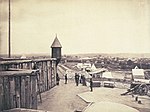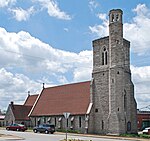Herschel Greer Stadium

Herschel Greer Stadium was a Minor League Baseball park in Nashville, Tennessee, on the grounds of Fort Negley, an American Civil War fortification, approximately two mi (3.2 km) south of the city's downtown district. The facility closed at the end of the 2014 baseball season and remained deserted for over four years until its demolition in 2019. Following an archaeological survey, the land is expected to be reincorporated into Fort Negley Park. Greer was opened in 1978 for the Nashville Sounds, an expansion franchise of the Double-A Southern League who moved to the Triple-A American Association in 1985 and to the Triple-A Pacific Coast League in 1998. The stadium played host to the team until 2014. The subject of numerous upgrades and repairs to maintain its functionality, Greer became one of the oldest stadiums used by a Triple-A team and had fallen well below professional baseball's standards for a stadium at that class level by the end of its use. For over a decade, the Sounds attempted to secure agreements with the Metropolitan Government of Nashville and Davidson County for a new ballpark to replace Greer, eventually resulting in the construction of First Tennessee Park, which became the Sounds' new home in 2015. Amidst the Sounds' 37-season run, Greer simultaneously hosted two professional baseball clubs in 1993 and 1994, acting as a temporary home to a displaced Southern League franchise known during that period as the Nashville Xpress. The stadium also saw occasional use as a venue for college baseball, high school football, and charity softball events. It was the site of three minor league all-star games, eight no-hitters, including one perfect game, and a 24-inning game which tied the record for the longest game in Pacific Coast League history. The stadium was best recognized by its distinctive guitar-shaped scoreboard.
Excerpt from the Wikipedia article Herschel Greer Stadium (License: CC BY-SA 3.0, Authors, Images).Herschel Greer Stadium
Chestnut Street, Nashville-Davidson
Geographical coordinates (GPS) Address Nearby Places Show on map
Geographical coordinates (GPS)
| Latitude | Longitude |
|---|---|
| N 36.143333333333 ° | E -86.773611111111 ° |
Address
Chestnut Street
37203 Nashville-Davidson
Tennessee, United States
Open on Google Maps







